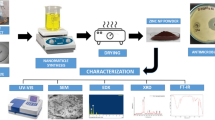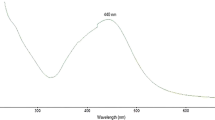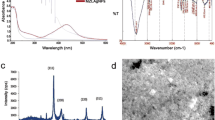Abstract
On a global basis, colorectal cancer is one of the foremost causes of cancer-related death rate. The present research encompasses the fabrication of CuO nanoparticles employing leaf extract of Coleus amboinicus (CA–CuO NPs) and evaluating the anti-cancerous capability against HCT 116 cells (Colon cancer). The fabricated CA–CuO NPs were assessed by UV–Vis. spectrophotometer, FT-IR, SEM, EDAX and DLS. The cytotoxic action upon the HCT 116 cells was evaluated using MTT, trypan blue exclusion assay, phase contrast microscopy, DAPI, and MMP Staining. The oxidative stress markers such as nitric oxide (NO), lipid peroxidation (LPO), and reactive oxygen species (ROS) levels were analyzed. The antioxidant markers including catalase (CAT) and superoxide dismutase (SOD) were further analyzed. Using RT-PCR, the expression levels of genes including Bax, p53, and Bcl-2 were analyzed. The peak at 225 nm in the UV spectrum disclosed the formation of CA–CuO NPs. The possible existence of phytoconstituents responsible for reducing CuO ions was confirmed by FT-IR results. The SEM images showed the formation of irregular rice-shaped and elongated tetragonal-shaped CuO nanoparticles. The EDAX results confirm the existence of C, Cu, O and S peaks. The DLS findings revealed average particle size of CA–CuO NPs was 118.6 nm. The MTT assay demonstrated a dose-dependent, substantial suppression of HCT 116 cell growth, with an IC50 of 12.5 µg/mL indicating 49.71% inhibition. The proportion of viable cells in the trypan blue exclusion assay steadily dropped as treated cells suffered morphological deformity as observed by phase contrast microscopy. The DAPI and MMP staining revealed an increase in dead cells in a dose-wise manner. Oxidative stress indicators including NO, LPO, and ROS levels were considerably higher in the treated groups than in the control. The antioxidant markers such as CAT and SOD declined significantly in treated groups. The endpoints of the gene expression study revealed the overexpression of tumor suppression genes Bax and p53 and anti-apoptotic gene, Bcl-2 was unexpressed. The biogenically synthesized CA–CuO NPs exhibited exceptional anti-cancerous activity towards HCT 116 cell line.

















Similar content being viewed by others
Data Availability
No datasets were generated or analysed during the current study.
References
E. Julianti, I.A. Abrian, M.S. Wibowo, M. Azhari, N. Tsurayya, F. Izzati et al., Secondary metabolites from marine-derived fungi and actinobacteria as potential sources of novel colorectal cancer Drugs. Marine Drugs (2022). https://doi.org/10.3390/md20010067
P. Rawla, T. Sunkara, A. Barsouk, Epidemiology of colorectal cancer: incidence, mortality, survival, and risk factors. Przeglad Gastroenterol. 14, 89–103 (2019)
V. Gnanavel, V. Palanichamy, S.M. Roopan, Biosynthesis and characterization of copper oxide nanoparticles and its anticancer activity on human colon cancer cell lines (HCT-116). J. Photochem. Photobiol. B 171, 133–138 (2017). https://doi.org/10.1016/j.jphotobiol.2017.05.001
T.A. Zughaibi, A.A. Mirza, M. Suhail, N.R. Jabir, S.K. Zaidi, S. Wasi et al., Evaluation of anticancer potential of biogenic copper oxide nanoparticles (CuO NPs) against breast cancer. J. Nanomater. (2022). https://doi.org/10.1155/2022/5326355
N. Verma, N. Kumar, Synthesis and biomedical applications of copper oxide nanoparticles: an expanding horizon. ACS Biomater. Sci. Eng. 5(3), 1170–1188 (2019)
P.C. Nagajyothi, P. Muthuraman, T.V.M. Sreekanth, D.H. Kim, J. Shim, Green synthesis: In-vitro anticancer activity of copper oxide nanoparticles against human cervical carcinoma cells. Arab. J. Chem. 10(2), 215–225 (2017)
P. Korde, S. Ghotekar, T. Pagar, S. Pansambal, R. Oza, D. Mane, Plant extract assisted eco-benevolent synthesis of selenium nanoparticles-a review on plant parts involved, characterization and their recent applications. J. Chem. Rev. 2, 157–168 (2020)
A.K. Saim, F.N. Kumah, M.N. Oppong, Extracellular and intracellular synthesis of gold and silver nanoparticles by living plants: A review. Nanotechnol. Environ. Eng. https://doi.org/10.1007/s41204-020-00095-9
G. Arumugam, M.K. Swamy, U.R. Sinniah, Plectranthus amboinicus (Lour.) spreng: botanical, phytochemical, pharmacological and nutritional significance. Molecules (2016). https://doi.org/10.3390/molecules21040369
A.P. Gurgel, J.G. da Silva, A.R. Grangeiro et al., In vivo study of the anti-inflammatory and antitumor activities of leaves from Plectranthus amboinicus (Lour.) Spreng (Lamiaceae. J. Ethnopharmacol. 125, 361–363 (2009)
V. Kulkarni, P. Kulkarni, Synthesis of copper nanoparticles with aegle marmelos leaf extract. Nanosci. Nanotechnol. 8, 401–404 (2014)
P.P.N.V. Kumar, U. Shameem, P. Kollu, R.L. Kalyani, S.V.N. Pammi, Green synthesis of copper oxide nanoparticles using aloe vera leaf extract and its antibacterial activity against fish bacterial pathogens. Bionanoscience 5(3), 135–139 (2015)
T. Mosmann, Rapid colorimetric assay for cellular growth and survival: application to proliferation and cytotoxicity assays. J. Immunol. Methods 65(1–2), 55–63 (1983). https://doi.org/10.1016/0022-1759(83)90303-4
Y.G. Yuan, S. Zhang, J.Y. Hwang, I.K. Kong, Silver nanoparticles potentiates cytotoxicity and apoptotic potential of camptothecin in human cervical cancer cells. Oxid. Med. Cell Longev. (2018). https://doi.org/10.1155/2018/6121328
X. Chen, X. Zhao, Y. Gao, J. Yin, M. Bai, F. Wang, Green synthesis of gold nanoparticles using carrageenan oligosaccharide and their in vitro antitumor activity. Mar. Drugs 16(8), 277 (2018)
P. Raja Singh, R. Arunkumar, V. Sivakamasundari, G. Sharmila, P. Elumalai, E. Suganthapriya et al., Anti-proliferative and apoptosis inducing effect of nimbolide by altering molecules involved in apoptosis and IGF signalling via PI3K/Akt in prostate cancer (PC-3) cell line. Cell. Biochem. Funct. 32(3), 217–228 (2014)
H. Bamehr, M. Saidijam, D. Dastan, R. Amini, M. Pourjafar, R. Najafi, Ferula pseudalliacea induces apoptosis in human colorectal cancer HCT-116 cells via mitochondria-dependent pathway. Arch. Physiol. Biochem. 125(3), 284–291 (2019)
F.S. Wahyuni, D.A.I. Ali, N.H. Lajis, Dachriyanus, Anti-inflammatory activity of isolated compounds from the stem bark of Garcinia cowa Roxb. Pharmacognosy J. 9(1), 55–57 (2017)
H. Ohkawa, N. Ohishi, K. Yagi, Assay for lipid peroxides in animal tissues by thiobarbituric acid reaction. Anal. Biochem. (1979). https://doi.org/10.1016/0003-2697(79)90738-3
S. Noori, A.R. Kiasat, M. Kolahi, R. Mirzajani, S.M. Seyyed Nejad, Determination of secondary metabolites including curcumin in Rheum ribes L. and surveying of its antioxidant and anticancer activity. J. Saudi Chem. Soc. (2022). https://doi.org/10.1016/j.jscs.2022.101479
L. Goth, A simple method for determination of serum catalase activity and revision of reference range. Clin. Chim. (1991). https://doi.org/10.1016/0009-8981(91)90067-M
S. Luo, X. Jiang, L. Jia, C. Tan, M. Li, Q. Yang et al., In vivo and in vitro antioxidant activities of methanol extracts from olive leaves on Caenorhabditis elegans. Molecules (2019). https://doi.org/10.3390/molecules24040704
E.M. Sabi, N.O. AlAfaleq, A.H. Mujamammi, S.T. Al-Shouli, Z.M. Althafar, L.S. Bin Dahman et al., Gramine exerts Cytoprotective effects and antioxidant properties against H2O2-Induced oxidative stress in HEK 293 cells. Appl. Biochem. Biotechnol. 2023
D. Acharya, S. Satapathy, P. Somu, U.K. Parida, G. Mishra, Apoptotic effect and anticancer activity of biosynthesized silver nanoparticles from marine algae Chaetomorpha linum extract against human colon cancer cell HCT-116. Biol. Trace Elem. Res. 199(5), 1812–1822 (2021)
F. Jiang, J.Y. Zhou, D. Zhang, M.H. Liu, Y.G. Chen, Artesunate induces apoptosis and autophagy in HCT116 colon cancer cells, and autophagy inhibition enhances the artesunate-induced apoptosis. Int. J. Mol. Med. 42(3), 1295–1304 (2018)
M. Nazeri, A. Mirzaie-asl, M. Saidijam, M. Moradi, Methanolic extract of Artemisia absinthium prompts apoptosis, enhancing expression of Bax/Bcl-2 ratio, cell cycle arrest, caspase-3 activation and mitochondrial membrane potential destruction in human colorectal cancer HCT-116 cells. Mol. Biol. Rep. 47(11), 8831–8840 (2020)
P. Su, V.P. Veeraraghavan, S. Krishna Mohan, W. Lu, A ginger derivative, zingerone—a phenolic compound—induces ROS-mediated apoptosis in colon cancer cells (HCT-116). J. Biochem. Mol. Toxicol. (2019). https://doi.org/10.1002/jbt.22403
P. Fortina, L.J. Kricka, D.J. Graves, J. Park, T. Hyslop, F. Tam et al., Applications of nanoparticles to diagnostics and therapeutics in colorectal cancer. Trends Biotechnol. 25(4), 145–152 (2007)
S. Parthasarathy, S. Jayacumar, S. Chakraborty, P. Soundararajan, D. Joshi, K. Gangwar et al., Fabrication and Characterization of Copper Nanoparticles by Green Synthesis Approach Using Plectranthus Amboinicus Leaves Extract. https://doi.org/10.21203/rs.3.rs-55984/v1
S. Sukumar, A. Rudrasenan, D. Padmanabhan Nambiar, Green-synthesized rice-shaped copper oxide nanoparticles using Caesalpinia bonducella seed extract and their applications. ACS Omega 5(2), 1040–1051 (2020)
M.A. Khan, N. Nayan, M.K. Shadiullah, Ahmad, C.F. Soon, Surface study of cuo nanopetals by advanced nanocharacterization techniques with enhanced optical and catalytic properties. Nanomaterials. 10(7), 1–18 (2020)
K. Velsankar, V. Vinothini, S. Sudhahar, M.K. Kumar, S. Mohandoss, Green synthesis of CuO nanoparticles via Plectranthus amboinicus leaves extract with its characterization on structural, morphological, and biological properties. Appl. Nanosci. (Switzerland). 10(10), 3953–3971 (2020)
C. Tamuly, I. Saikia, M. Hazarika, M.R. Das, Reduction of aromatic nitro compounds catalyzed by biogenic CuO nanoparticles. RSC Adv. 4(95), 53229–53236 (2014)
H.C.A. Murthy, T. Desalegn, M. Kassa, B. Abebe, T. Assefa, Synthesis of green copper nanoparticles using medicinal plant Hagenia abyssinica (Brace) JF. Gmel. leaf extract: antimicrobial properties. J Nanomater. (2020). https://doi.org/10.1155/2020/3924081
S.D. Ashtaputrey, P.D. Ashtaputrey, N. Yelane, Green synthesis and characterization of copper nanoparticles derived From Murraya koenigii leaves extract. journal of chemical and pharmaceutical sciences [Internet]. Available from: www.jchps.com
S.A. Akintelu, A.S. Folorunso, F.A. Folorunso, A.K. Oyebamiji, Green synthesis of copper oxide nanoparticles for biomedical application and environmental remediation, vol. 6 (Elsevier, Heliyon, 2020)
Z. Alhalili, Green synthesis of copper oxide nanoparticles CuO NPs from Eucalyptus goboulus leaf extract: adsorption and design of experiments. Arab. J. Chem. (2022). https://doi.org/10.1016/j.arabjc.2022.103739
S. Tabrez, A.U. Khan, A.A. Mirza, M. Suhail, N.R. Jabir, T.A. Zughaibi et al., Biosynthesis of copper oxide nanoparticles and its therapeutic efficacy against colon cancer. Nanotechnol. Rev. 11(1), 1322–1331 (2022)
A. Saraste, K. Pulkki (2000) Morphologic, and biochemical hallmarks of apoptosis [Internet]. Vol. 45, Cardiovascular Research. Available from: www.elsevier.com/locate/cardioreswww.elsevier.nl/locate/cardiores
M. Kouhkan, P. Ahangar, L.A. Babaganjeh, M. Allahyari-Devin, Biosynthesis of copper oxide nanoparticles using Lactobacillus casei Subsp. Casei and its anticancer and antibacterial activities. Curr. Nanosci. 16(1), 101–111 (2019)
M. Jia, W. Zhang, T. He, M. Shu, J. Deng, J. Wang et al., Evaluation of the genotoxic and oxidative damage potential of silver nanoparticles in human NCM460 and HCT116 cells. Int. J. Mol. Sci. (2020). https://doi.org/10.3390/ijms21051618
Acknowledgements
The authors extend their appreciation to the Deputyship for Research and Innovation, “Ministry of Education” in Saudi Arabia for funding this research (IFKSUOR3-033-2).
Funding
The authors received a financial support from the Deputyship for Research and Innovation, “Ministry of Education” in Saudi Arabia for funding this research (IFKSUOR3-033-2).
Author information
Authors and Affiliations
Contributions
Project design and parameter analysis completed by AHM, KMS, SFA; Collected data analysed by ZMA, NOA, EMS. Manuscript writing was performed by contribution of all authors.
Corresponding author
Ethics declarations
Competing interest
The authors declare no competing interests.
Ethical Approval
Not Applicable.
Additional information
Publisher’s Note
Springer Nature remains neutral with regard to jurisdictional claims in published maps and institutional affiliations.
Rights and permissions
Springer Nature or its licensor (e.g. a society or other partner) holds exclusive rights to this article under a publishing agreement with the author(s) or other rightsholder(s); author self-archiving of the accepted manuscript version of this article is solely governed by the terms of such publishing agreement and applicable law.
About this article
Cite this article
Mujamammi, A.H., Sumaily, K.M., Alnomasy, S.F. et al. Phyto-fabrication and Characterization of Coleus amboinicus Inspired Copper Oxide Nanoparticles and Evaluation of Its Apoptotic and Anti-cancerous Activity Against Colon Cancer Cells (HCT 116). J Inorg Organomet Polym (2024). https://doi.org/10.1007/s10904-024-02997-6
Received:
Accepted:
Published:
DOI: https://doi.org/10.1007/s10904-024-02997-6




